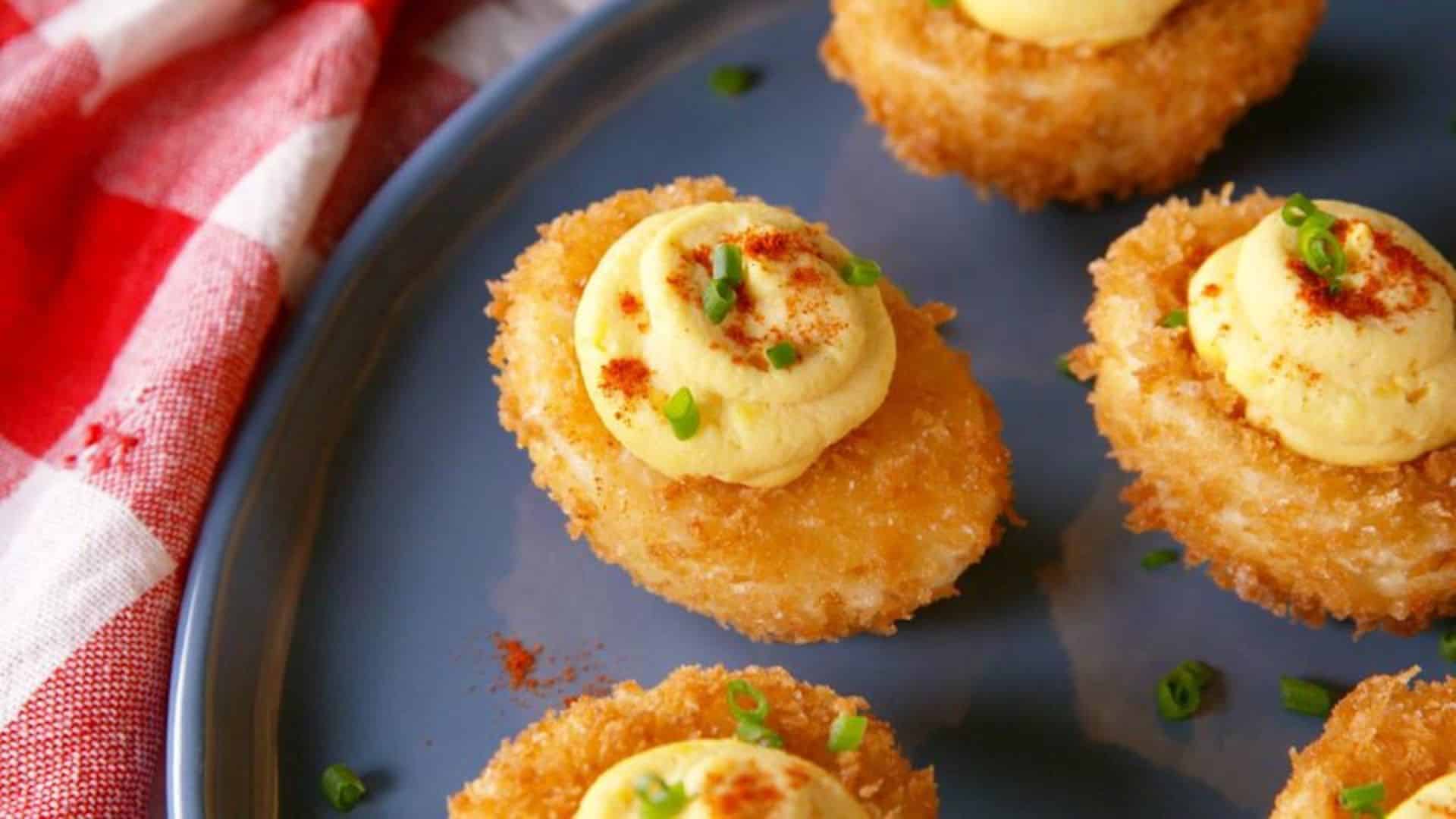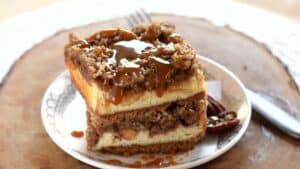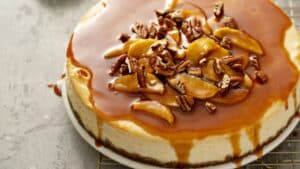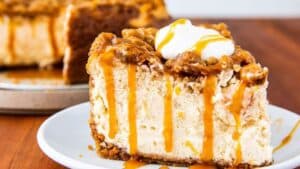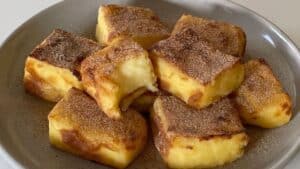You ever bite into somethin’ and just… stop talking? That’s what happens with crispy fried deviled eggs. They shut people up. In the best way. You get the crunch, then the creamy hit of yolk and spice. It’s indulgence with just enough cleverness to feel classy. And yet, they’re not fussy. That’s why more chefs, caterers, and food pros are adding ’em to menus across the board.
This ain’t just a party snack. It’s a technique, a texture, a contrast of temperatures and flavors that, when done right, becomes the talk of the table. If you’re a culinary professional or just someone who knows a béchamel from a beurre blanc this one’s worth your time. Let’s break it down properly.

Why Crispy Fried Deviled Eggs Matter Right Now
Trends come and go. But right now, deviled eggs are riding high. Not just as picnic food. They’ve climbed their way onto tasting menus, cocktail pairings, and even brunch boards in Michelin-starred kitchens. According to Datassential’s 2023 Menu Trends Report, deviled eggs have seen a 31% increase on appetizer menus over the past five years. That’s not a fad. That’s a shift.
Why? Because they’re customizable. Because they can swing Southern or go global. Because they look good on social. But most of all, because they deliver what diners want: crunch, cream, spice, nostalgia, and surprise all in a two-bite package.
And then… you fry them. Boom.
The Anatomy of a Perfect Fried Deviled Egg
Here’s the thing deviled eggs are already a sensory experience. But when you add a crisp shell around that tender white, it’s game over. You turn a soft egg into a finger food powerhouse.
Let’s get nerdy with it. The construction matters. The egg white needs to be just firm enough to hold its shape post-boil and through the fry. Too soft, and it collapses in the oil. Too hard, and you’re chewing on rubber.
Yolk mixture? That’s where you show off. Classic mustard-mayo-paprika works fine, sure. But chefs are doing things like kimchi yolk mousses, pimento cheese centers, even foie gras-infused fillings. A restaurant in Austin serves theirs with whipped goat cheese and harissa oil. They sell out every Friday.
And if you really wanna flex? Pipe the filling in after the fry. It stays cooler, creamier. But yeah, that takes skill.
Choosing the Right Egg – Size, Freshness, Shell
Let’s clear something up older eggs are easier to peel, yes. But they’re also more sulfuric. That’s a problem if you’re doing anything elevated with the filling.
For pro kitchens, we recommend eggs that are 5–7 days old. Medium or large size no jumbos. Uniform shape, clean shells, no hairline cracks.
Steam ’em. Don’t boil ’em. Trust me on this. Steaming gives you fewer green rings and more consistent whites. Plus it’s faster. About 12 minutes for set yolks, then straight into an ice bath. No skipping the shock. That sets the whites and keeps things tidy for breading.
Bread It Like You Mean It
Now we get into technique territory. Breaded egg whites are slippery customers. Most folks do the classic three-step: flour, egg wash, breadcrumb. But here’s where it gets interesting.
Some chefs swap in panko mixed with pulverized pork rinds for extra snap. Others use crushed wasabi peas or rice crackers for fusion texture. Even semolina’s been used at spots like Momofuku to make the crust really sing. Depends on the vibe you’re chasing.
Flour is non-negotiable. That dry coat is what helps the egg wash cling. Without it, you’re getting patchy crusts, and nobody wants that. Season every layer too flour, egg wash, breadcrumb. Basic kitchen law.
Fry at 350°F for just about a minute. No longer. You’re not cooking the egg you’re just crisping the outside. Pull too late, and you risk molten yolk exploding like an eggy grenade. Pull too early, and the crust’s limp. It’s a tightrope, mate.
Filling – Where the Magic Happens
Look, if you’re still just mashing yolks with store-bought mayo and yellow mustard, that’s fine for a cookout. But if you’re serving guests who pay $18 for apps, you gotta go deeper.
Here’s a breakdown of high-performing filling styles:
1. Whipped Fillings
Use a food processor. Add yolks, Dijon, white pepper, a splash of white balsamic, and crème fraîche. Blitz till silk. The texture? Cloud-like. Finish with a touch of smoked paprika butter folded in.
2. Umami-Bomb Fillings
Miso, sriracha, fish sauce. Maybe a little mushroom powder. One chef in SF pipes theirs over charred scallion oil with black garlic. They call it “Nuclear Egg.” People queue.
3. Cheese-Driven Fillings
Shaved Parmesan, gorgonzola, aged cheddar all blended into the yolk with a bit of sour cream. Richer than most desserts.
4. Vegan Hack Versions
Use firm tofu and black salt (kala namak) to mimic yolk funk. It’s not traditional, no. But it opens the door for everyone.
Keep the ratio tight. No slop. The filling should pipe clean, hold shape, but melt on tongue.
Garnishes and Final Touches
Now we’re at plating. The moment of truth.
Microgreens? Always a safe play. But fried shallots, pickled mustard seeds, or a single anchovy curl can say way more. Even edible gold leaf if you’re going all out (a Vegas joint does this and charges $22. Absurd but they sell out).
Don’t overcrowd the plate. Two halves per portion is perfect. Let ’em breathe. A zigzag of sauce under the egg maybe aioli, chili oil, or even a whipped avocado purée can set the tone and tie flavors together.
Heat? A must. Even just a whisper of cayenne or a dab of chili crisp wakes up the whole bite.
And serve warm. Not hot, not cold. Warm. Room-temp deviled eggs just don’t hit right.
Common Mistakes Even Pros Make
1. Overboiling Eggs
Green-ringed yolks kill the visual. It’s textbook overcooking. Use a timer, not your gut.
2. Underseasoning the Fillings
The yolk base needs acid, salt, and sometimes sweetness. Balance is everything. Taste, adjust, then taste again.
3. Letting Fried Whites Sit Too Long
Fried deviled eggs must be served fresh. Don’t prep these hours in advance. They wilt. They die. They become sad.
4. Skipping the Rest Between Fry and Fill
Give the fried halves 2–3 minutes on a rack before piping. That keeps the base crisp. Straight-from-oil to piping? Big mistake. Melted filling. Oily disaster.
Emerging Trends and Innovation
Professional kitchens are doing wild stuff right now. Mini fried deviled quail eggs at wine bars. Beet-dyed eggs for bright pink whites. Even dessert versions sweet yolk mousse inside chocolate-dipped “whites.”
One pop-up in LA makes Korean-style deviled eggs with gochujang, sesame oil, and fried nori crisps. They pair them with makgeolli. Genius.
Air-fried versions are gaining traction too. Not quite the same texture, but less mess and more consistency during service. Plus: no fryer smell sticking to your chef coat.
Younger diners? They love riffs. Make ‘em Nashville hot. Or fill ‘em with wasabi cream cheese. You’ll get the Instagram love and the ticket volume.
Real-World Example: Southern Fusion Bistro in Charleston
Chef May Ellis at Southern Fusion Bistro turned a $2 egg into a $12 bestseller. Her method? Applewood-smoked yolks, pimento cheese, crusted in cornbread crumbs. Topped with a dab of pepper jelly and a chive blossom.
She sold 78 orders her first week. No discount. No promo. Just word of mouth.
Now? They’re on her tasting menu with a bourbon cocktail. That’s evolution.
Final Thoughts: Are Fried Deviled Eggs Worth the Trouble?
Short answer? Yes. Long answer? Yes, if you care about giving guests something memorable. Something clever. Something that makes ‘em pause between bites and go, “Wait…what was that?”
The prep’s not hard. But it does take precision. The payoff? Massive. You get versatility, wow factor, and profit margin all in one.
Test it. Tweak it. Make it yours.
Because in the world of appetizers, fried deviled eggs ain’t just showing up. They’re taking over.
